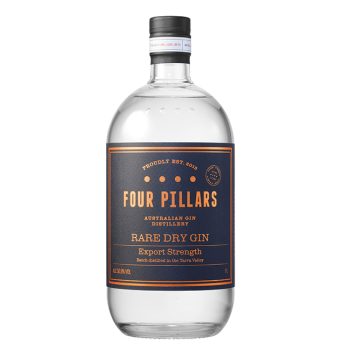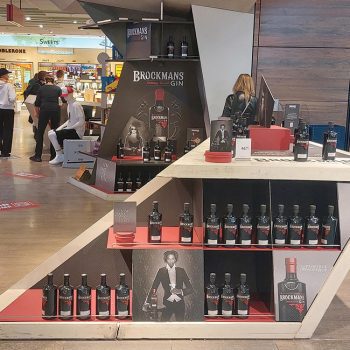Gin poised for growth in GTR
Gin brands are looking to create a buzz in global travel retail, with new expressions set to lure travellers returning to the channel. Here’s how producers are planning to make their marks in the year ahead.

*This feature was originally published in the February 2024 issue of The Spirits Business magazine.
Despite stagnant sales in mature markets such as the UK, the gin category is in a strong position for further growth in the global travel retail (GTR) channel.
After experiencing triple-digit gains in 2022, the competitive sector surpassed pre-pandemic levels with growth of approximately 6% between 2019 and 2023, IWSR Drinks Market Analysis has estimated. IWSR expects the category to rise by a healthy 8% between 2022 and 2023, and at a compound annual growth rate (CAGR) of 5% in the five years to 2027.
The category’s growth came mainly from European travellers who remain the main consumer group for gin worldwide, according to Jairo Suarez, head of global travel retail (GTR) insights at IWSR.
With a strong presence in Europe, super-premium gin brand Brockmans is keen to take on the GTR channel after growing its sales in domestic markets. The brand reported a sales increase of 73% in GTR in 2022, led by Europe, with some “good growth in Latin America” says Pierpaolo Indelicato, vice-president, international at Brockmans. The brand’s share of the super-premium gin segment in GTR is approximately 2%, says Indelicato, who believes “headroom for growth is significant”.
After securing “very strong domestic” positions in markets such as the UK, Spain and Germany, Indelicato said it was a natural step to “start building the brand in duty free”. The company is working with key GTR retailers to secure listings, visibility and activations to replicate success in domestic markets. Through duty free retailer Heinemann, Brockmans has launched its Agave Cut expression in Germany and Austria, with the aim of taking it to Amsterdam next.
 Last year the GTR channel was rife with activity as brands made up for time lost during locksdowns with exclusive products and activations. Brands such as Bombay Sapphire and Monkey 47 revealed new expressions, with the former revealing a Tuscan Juniper variant, while the latter launched a Traveller’s Compendium gift pack designed to be a collector’s item. Another example was Australian producer Four Pillars, which released its first GTR-only expression, Rare Dry Gin Export Strength at 50.8% ABV. David Hogan, director of GTR, said the brand hoped to entice the bartending community who love a higher-ABV product. The one-litre bottle landed on shelf in Heinemann’s Sydney Airport stores in July 2023, and there are “ongoing discussions” to bring the product to Heinemann’s vast EU network in the future.
Last year the GTR channel was rife with activity as brands made up for time lost during locksdowns with exclusive products and activations. Brands such as Bombay Sapphire and Monkey 47 revealed new expressions, with the former revealing a Tuscan Juniper variant, while the latter launched a Traveller’s Compendium gift pack designed to be a collector’s item. Another example was Australian producer Four Pillars, which released its first GTR-only expression, Rare Dry Gin Export Strength at 50.8% ABV. David Hogan, director of GTR, said the brand hoped to entice the bartending community who love a higher-ABV product. The one-litre bottle landed on shelf in Heinemann’s Sydney Airport stores in July 2023, and there are “ongoing discussions” to bring the product to Heinemann’s vast EU network in the future.
In its homeland of Australia, Four Pillars is the number-two biggest-selling gin in travel retail after category behemoth Bombay Sapphire. Hogan also highlighted strong growth in nearby New Zealand and Southeast Asia. Singapore is the brand’s next biggest market. Last summer Sydney-based food-and-beverage marketing company Lion took full ownership of Four Pillars, and Hogan says the group’s “massive” presence in New Zealand will help the brand grow significantly there. The company has given Four Pillars a “good leg-up in the market”, where the brand has been underserved, Hogan notes. An “aggressive growth strategy” in New Zealand is planned for 2024.
Cruise control
The cruise channel is also an area of focus for Four Pillars, which partnered with Celebrity Cruises to offer gin-and-food tasting experiences on board to customers. Hogan says the brand is starting to tap into the US. “If you can get onto a cruise ship in the US, that’s essentially American passengers that are enjoying the products for three to seven days,” he says.
Brockmans is also eyeing the cruise channel, and is hoping to secure a listing in the year ahead. Indelicato hopes to “leverage” European cruises, and believes there is a big opportunity in the Caribbean, where it could target a “strong expat community of Europeans”.
Having a listing on flights is also lucrative for Brockmans, and Indelicato would like to “strike a partnership” with British brands such as Virgin Airways, or expand into lounges, including British Airways.
Despite heavy discounting for gin in the UK’s airports, the market remains the biggest one for Scottish brand Edinburgh Gin, which has a “sizeable presence”, according to William Ovens, Ian Macleod Distillers’ GTR director.
 The brand is the number-one super-premium gin in UK travel retail. “We are undertaking some high-profile activations this summer in key locations, including the key London airports,” he says.
The brand is the number-one super-premium gin in UK travel retail. “We are undertaking some high-profile activations this summer in key locations, including the key London airports,” he says.
As well as extensive distribution in Europe, the brand is looking to the Americas, where it has a distribution partnership with Disc.
“We see real potential for Edinburgh Gin in this region, and have had a great deal of interest from key operators there, so this is a hugely exciting new chapter,” says Ovens. “In line with our domestic scale, Disc will initially focus on the US travel retail market.”
The company has also revealed a new design for the range, which will make its travel retail debut in April. Edinburgh Gin has expanded the availability of its Strawberry & Pink Peppercorn expression in the channel, and has a seen a “real uplift in sales” for its Seaside variant and core gin. A new flavour is also in the pipeline, and the company is set to announce its “largest ever investment” in travel retail in the second quarter of the year.
IWSR has highlighted some key trends in the channel in the year ahead, with consumers exploring new flavours in gin, sustainable options, and low-and-no products. Suaraz says: “Non-alcoholic and low-alcohol gin alternatives are slowly gaining popularity in travel retail.” He also notes that consumers are “eager to fulfil their travel desires with an expanded flavour offering”.
He added: “Gin owners are increasing their portfolio with not just the usual citrus gin flavours such as lemon or orange, but also releasing brand lines that cover other tropical and botanical flavours, especially Asian ones, such as yuzu, kumquat, lemongrass, or matcha, which in some cases are even initially released as travel retail-exclusive products.”
While the category has enjoyed strong growth following years of restricted travel, Ovens warns that the main challenge is increasing competition from other gins as shelf space dwindles.
He says: “The category has enjoyed a sustained period of rapid growth, meaning that the share of shelf space grew and grew. Now that rate of growth has slowed, and there is more pressure on shelf presence, and new listings are harder to secure. There are definite economic challenges, which impact all categories.”
Hogan believes fast-growing categories such as Tequila mean that retailers are further reducing shelf space for the gin sector. Like Ovens, Indelicato also recognises that limited shelf space is a challenge in established markets such as Europe. Looking to other non-traditional gin regions, he says the category remains underdeveloped in markets such as Asia, where drinkers favour whisky and Cognac, signalling an opportunity to grow the sector’s consumer base.
Related news
The Botanist Distiller's Strength launches in UK
